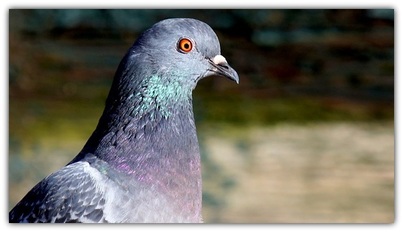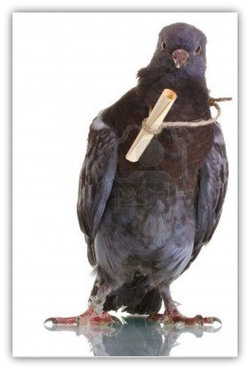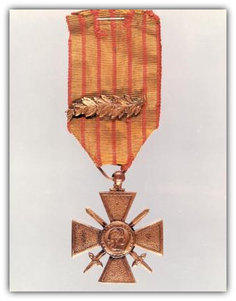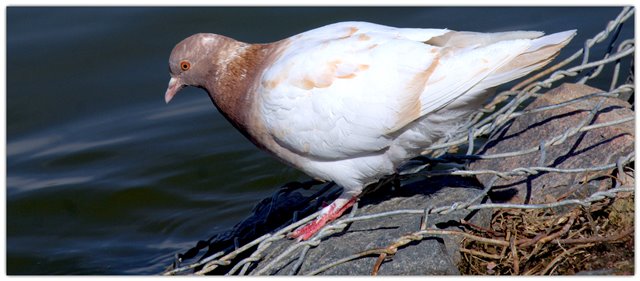 photo by Betsy Seeton
photo by Betsy Seeton The common pigeon brings about thoughts of public parks, an obsession for bread crumbs, white gunk on your windshield and not much else. Fortunately, these characteristics are mostly associated with the Feral Pigeon, or better known as the, Street Pigeon. Remarkably, this pigeon is only one out of its 310 other species, which are spread all across the globe. Although it seems very unnatural, New York City is home to over one-million pigeons, more than any other place in the world! One might assume that a creature as simple as the pigeon can only amount to simple tasks. However, the contribution of these gentle birds to our society goes far beyond gnawing bread in parks, or leaving a nice surprise on your favorite car.
Columbidae, is the scientific name for the clade of birds that the dove and pigeon belong to. The earliest account of pigeons dates all the way back to 3000 BC through images unearthed by archaeologists in Mesopotamia. It was here that the symbolic white dove was first bred by the Sumerians, through the wild pigeons we see in our cities today. As a result of its pure, virtuous look and its references in the Bible, this white dove became widely worshipped, and gained a sacred reputation that still holds true even today.
In the middle ages, the pigeon was also widely used as a means of communication, because it could be quickly domesticated and taught into sending and receiving messages. This unique ability of theirs resurfaced again in 1871, during the Franco-Prussian War. The French used hot air balloons to transport carrier pigeons past enemy lines and into Paris. They carried vital information that benefited the soldiers in Paris greatly for the next four months of the siege. Due to their success in this war, they were found extremely valuable, and were used again in World War I. Thousands of pigeons were trained to not only carry messages, but also serve as aerial reconnaissance. These brave birds flew miles across the battlefield to deliver messages and intel that would save hundreds of lives.
In the middle ages, the pigeon was also widely used as a means of communication, because it could be quickly domesticated and taught into sending and receiving messages. This unique ability of theirs resurfaced again in 1871, during the Franco-Prussian War. The French used hot air balloons to transport carrier pigeons past enemy lines and into Paris. They carried vital information that benefited the soldiers in Paris greatly for the next four months of the siege. Due to their success in this war, they were found extremely valuable, and were used again in World War I. Thousands of pigeons were trained to not only carry messages, but also serve as aerial reconnaissance. These brave birds flew miles across the battlefield to deliver messages and intel that would save hundreds of lives.

Perhaps one of the most amazing stories was that of a carrier pigeon, by the name of Cher Ami (French for “dear friend”). During her final mission, she was tasked with the job of delivering a message for a battalion that was lost behind enemy lines. Two of their previous pigeons had already been shot down by the enemy that surrounded them, and Cher Ami was their last hope.
Holding these men’s lives in a small canister on her left leg, she bravely flew twenty-five miles and delivered the message to the division headquarters. On her first attempt, the enemy saw her flying out of the brush and eventually shot her down. Wounded by a bullet through her breast, this courageous pigeon still managed to take flight again. When she arrived, she was suffering from grievous wounds – a blind eye, a bullet hole through her breast, and one leg hanging from only a tendon.

This selfless act saved the lives of 194 men, forever grateful for her unparalleled courage and perseverance. Cher Ami received multiple awards, including the Croix de Guerre medal and the Oak Leaf Cluster. She died on June 13, 1919 from her wounds received in battle, and was mounted by a taxidermist. Today she is enshrined in the Price of Freedom exhibit in the National Museum of American History.
The pigeon, technically, is just another common breed of birds. We often take it for granted because of its common presence or dismiss it as annoying, but this feathered friend is truly a miracle of nature. Cher Ami was only one out of the thousands of pigeons that selflessly gave its life for our soldiers in the First World War, and many previous battles in years prior. This story shines a new light on the way these creatures contribute and even change, the course of world events. They prove that all animals, no matter how small or seemingly insignificant, can have a great impact in our daily lives.
The pigeon, technically, is just another common breed of birds. We often take it for granted because of its common presence or dismiss it as annoying, but this feathered friend is truly a miracle of nature. Cher Ami was only one out of the thousands of pigeons that selflessly gave its life for our soldiers in the First World War, and many previous battles in years prior. This story shines a new light on the way these creatures contribute and even change, the course of world events. They prove that all animals, no matter how small or seemingly insignificant, can have a great impact in our daily lives.
Works Cited
"Cher Ami." Wikipedia. Wikimedia Foundation, 14 July 2002. Web. 31 Jan. 2015.
"War Pigeon." Wikipedia. Wikimedia Foundation, 23 May 2004. Web. 31 Jan. 2015.
"Cher Ami - World War I Carrier Pigeon." Smithsonian. Encyclopedia Smithsonian, 17 Mar. 2007. Web. 31 Jan. 2015.
Woodbury, Sarah. "Messenger Pigeons in the Middle Ages." Romance and Fantasy in Medieval Wales. Sarah Woodbury, 25 Jan. 2013. Web. 31 Jan. 2015.
"The Pigeon Control Company." The Pigeon Control Company. Innolytics, 26 Sept. 2011. Web. 31 Jan. 2015.
"21 Amazing Facts About Pigeons." Pigeon Control Resource Centre. Independent Solutions For Pigeon Control Problems, 13 July 2009. Web. 31 Jan. 2015.
Notopoulos, Katie. "The Heartwarming Story Of Cher Ami, The Pigeon Who Saved 200 American Soldiers." Buzzfeed. BuzzFeed, 3 Jan. 2014. Web. 31 Jan. 2015.
"Columbidae." Wikipedia. Wikimedia Foundation, 16 May 2004. Web. 31 Jan. 2015.
"Feral Pigeon." Wikipedia. Wikimedia Foundation, 15 Dec. 2005. Web. 01 Feb. 2015.
"All About Birds." Browse by Bird Family (taxonomy). N.p., 10 Jan. 2012. Web. 01 Feb. 2015.
"Cher Ami." Wikipedia. Wikimedia Foundation, 14 July 2002. Web. 31 Jan. 2015.
"War Pigeon." Wikipedia. Wikimedia Foundation, 23 May 2004. Web. 31 Jan. 2015.
"Cher Ami - World War I Carrier Pigeon." Smithsonian. Encyclopedia Smithsonian, 17 Mar. 2007. Web. 31 Jan. 2015.
Woodbury, Sarah. "Messenger Pigeons in the Middle Ages." Romance and Fantasy in Medieval Wales. Sarah Woodbury, 25 Jan. 2013. Web. 31 Jan. 2015.
"The Pigeon Control Company." The Pigeon Control Company. Innolytics, 26 Sept. 2011. Web. 31 Jan. 2015.
"21 Amazing Facts About Pigeons." Pigeon Control Resource Centre. Independent Solutions For Pigeon Control Problems, 13 July 2009. Web. 31 Jan. 2015.
Notopoulos, Katie. "The Heartwarming Story Of Cher Ami, The Pigeon Who Saved 200 American Soldiers." Buzzfeed. BuzzFeed, 3 Jan. 2014. Web. 31 Jan. 2015.
"Columbidae." Wikipedia. Wikimedia Foundation, 16 May 2004. Web. 31 Jan. 2015.
"Feral Pigeon." Wikipedia. Wikimedia Foundation, 15 Dec. 2005. Web. 01 Feb. 2015.
"All About Birds." Browse by Bird Family (taxonomy). N.p., 10 Jan. 2012. Web. 01 Feb. 2015.


 RSS Feed
RSS Feed
